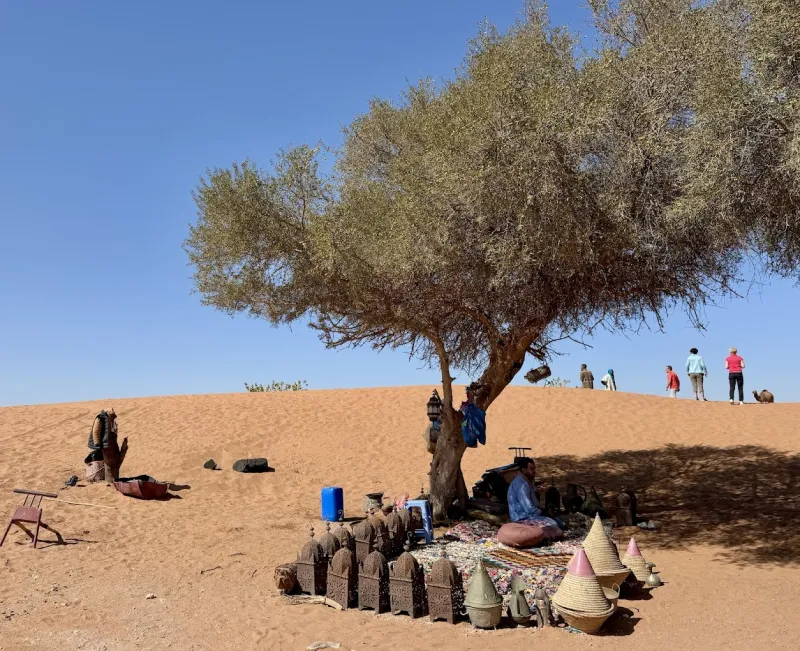Palazzo Bahia Marrakech: A Timeless Masterpiece of Moroccan Splendor
11 Mar 2025In the heart of Marrakech’s ancient medina, Palazzo Bahia stands as a testament to the opulence, artistry, and cultural fusion that define Morocco’s rich history. Originally built in the late 19th century, this exquisite palace—whose name evokes notions of brilliance and magnificence—offers visitors a glimpse into a bygone era of royal grandeur and refined craftsmanship. Its labyrinth of intricately decorated rooms, expansive courtyards, and lush gardens tells a story of ambition, elegance, and the enduring legacy of Moroccan design.
Historical Roots and the Vision Behind the Palace
A Dream of Grandeur
Palazzo Bahia was conceived during a period when Morocco was undergoing significant political and cultural transformations. Commissioned by a powerful noble, the palace was designed to reflect the pinnacle of wealth and taste. Its name, "Bahia," meaning "brilliance" or "magnificence," encapsulates the vision of its creators—to construct a residence that would rival the grandeur of the royal courts and celebrate the finest in Moroccan artistry.
Shifting Eras and Influences
Constructed in the late 1800s, Palazzo Bahia emerged at a time when Marrakech was becoming a melting pot of traditional Berber, Arab, and Andalusian influences. The palace’s architecture and decoration mirror this confluence of cultures, blending Islamic motifs with European tastes that were beginning to permeate Moroccan society. Over the decades, the building has witnessed the evolution of the city—from a bustling imperial capital to a modern tourist destination—yet it remains a cherished relic of its illustrious past.
Architectural Splendor: A Fusion of Art and Engineering
A Masterful Layout
The design of Palazzo Bahia is a study in balance and harmony. Spread over several interconnected wings, the palace is organized around spacious courtyards and passageways that create a fluid transition between indoor and outdoor spaces. This layout is not only practical for the hot Marrakech climate, as it encourages natural ventilation and cooling, but it also enhances the aesthetic appeal of the complex.
Intricate Details and Artisanal Craftsmanship
Every inch of Palazzo Bahia reveals the skilled craftsmanship of Morocco’s finest artisans. Elaborate stucco carvings, hand-painted tiles (zellige), and intricately carved cedar wood elements adorn the walls and ceilings, showcasing techniques passed down through generations. These decorative details are not merely ornamental—they tell stories of cultural pride, spirituality, and the intricate geometry that characterizes Islamic art.
The Interplay of Light and Space
One of the most striking aspects of the palace is the way natural light dances through its interior spaces. Arched doorways, high ceilings, and strategically placed windows create dynamic patterns of light and shadow, enhancing the textures and colors of the richly decorated surfaces. This play of light imbues the palace with a vibrant, almost ethereal quality, inviting visitors to pause and admire its subtle beauty.
Exquisite Interiors: Rooms That Tell Stories
Lavish Living Spaces
The interior rooms of Palazzo Bahia are designed to evoke a sense of luxury and intimacy. Each room is a carefully curated work of art, featuring sumptuous textiles, ornate furnishings, and a palette of warm, inviting colors. These spaces were originally intended to host royal gatherings, private ceremonies, and sumptuous feasts, and today they continue to inspire awe in every visitor.
Courtyards and Halls of Reflection
At the heart of the palace are its grand courtyards, which serve as tranquil oases amid the intricate network of rooms and corridors. These open-air spaces are often decorated with fountains, lush greenery, and comfortable seating areas, creating a serene environment where one can reflect on the passage of time. The courtyards also function as communal spaces where the boundaries between private and public life blur—a hallmark of traditional Moroccan design.
Symbolism in Every Detail
The decorative motifs found throughout Palazzo Bahia carry deep symbolic meanings. Geometric patterns, arabesques, and calligraphic inscriptions not only beautify the space but also serve as visual expressions of the infinite and the divine. Every carved detail and every painted border is a reminder of the cultural and spiritual values that have shaped Moroccan identity over centuries.
The Enchanting Gardens: Nature in Harmony with Architecture
Lush Green Retreats
No discussion of Palazzo Bahia is complete without mention of its spectacular gardens. These verdant enclaves provide a refreshing contrast to the intricacy of the palace’s interiors. Designed with the same meticulous care as the building itself, the gardens feature a variety of indigenous plants, fragrant orange trees, and carefully manicured hedges that evoke the natural beauty of Morocco.
The Language of Water
Water is a recurring motif in Moroccan architecture, symbolizing purity and life. In the gardens of Palazzo Bahia, ornate fountains and reflective pools create a soothing soundscape, their gentle murmurs harmonizing with the rustle of leaves. This integration of water and landscape not only cools the environment but also enhances the sensory experience of those strolling through the gardens.
A Place for Contemplation and Celebration
The gardens offer more than just aesthetic pleasure—they provide a space for contemplation and social interaction. Whether it is a quiet moment of solitude under the shade of a palm or a festive gathering with friends, the gardens of Palazzo Bahia invite visitors to pause, breathe, and connect with both nature and history.
Cultural Significance and Enduring Legacy
A Living Museum of Moroccan Heritage
Today, Palazzo Bahia stands as one of Marrakech’s most celebrated historical sites. It is a living museum that encapsulates the rich cultural heritage of Morocco, offering insight into the architectural innovations, artistic traditions, and social customs of the past. Visitors from around the globe come to experience this heritage firsthand, finding inspiration in the palace’s timeless beauty.
Inspiring Contemporary Art and Design
The influence of Palazzo Bahia extends beyond its immediate surroundings. Its architectural and decorative elements continue to inspire contemporary designers, artists, and architects both in Morocco and internationally. The palace’s blend of traditional techniques and innovative design has become a benchmark for those seeking to capture the essence of Moroccan elegance in modern creations.
Preservation for Future Generations
Recognizing its cultural and historical importance, efforts have been made to preserve and restore Palazzo Bahia. These conservation initiatives ensure that the palace remains an enduring symbol of Moroccan identity and a source of pride for future generations. Through careful maintenance and adaptive reuse, Palazzo Bahia continues to share its legacy of beauty, craftsmanship, and cultural dialogue.
Conclusion
Palazzo Bahia Marrakech is far more than an architectural landmark—it is a portal into Morocco’s vibrant past and a testament to the enduring power of art and tradition. From its intricately carved rooms and serene courtyards to its lush gardens and symbolic motifs, every element of the palace is a celebration of Moroccan ingenuity and aesthetic sensibility.
For those who wander through the winding alleys of Marrakech’s medina, a visit to Palazzo Bahia is an invitation to experience history in its most tangible form—a journey through time where every stone, every mosaic, and every whispered tale speaks of a glorious legacy that continues to shine brightly in the heart of Morocco.
Hi, I'm Camila Elise. I'm a passionate writer and design enthusiast at rents.ma, blending modern insights with the timeless elegance of Moroccan culture. Join me as I explore innovative ideas to transform your living space into a true reflection of your style.




